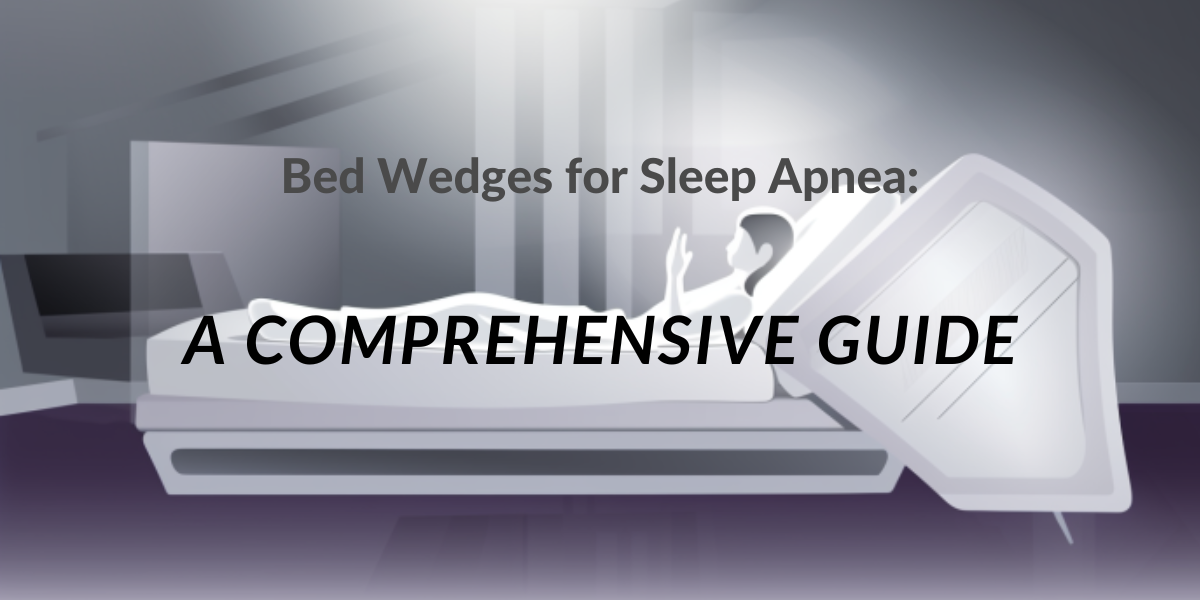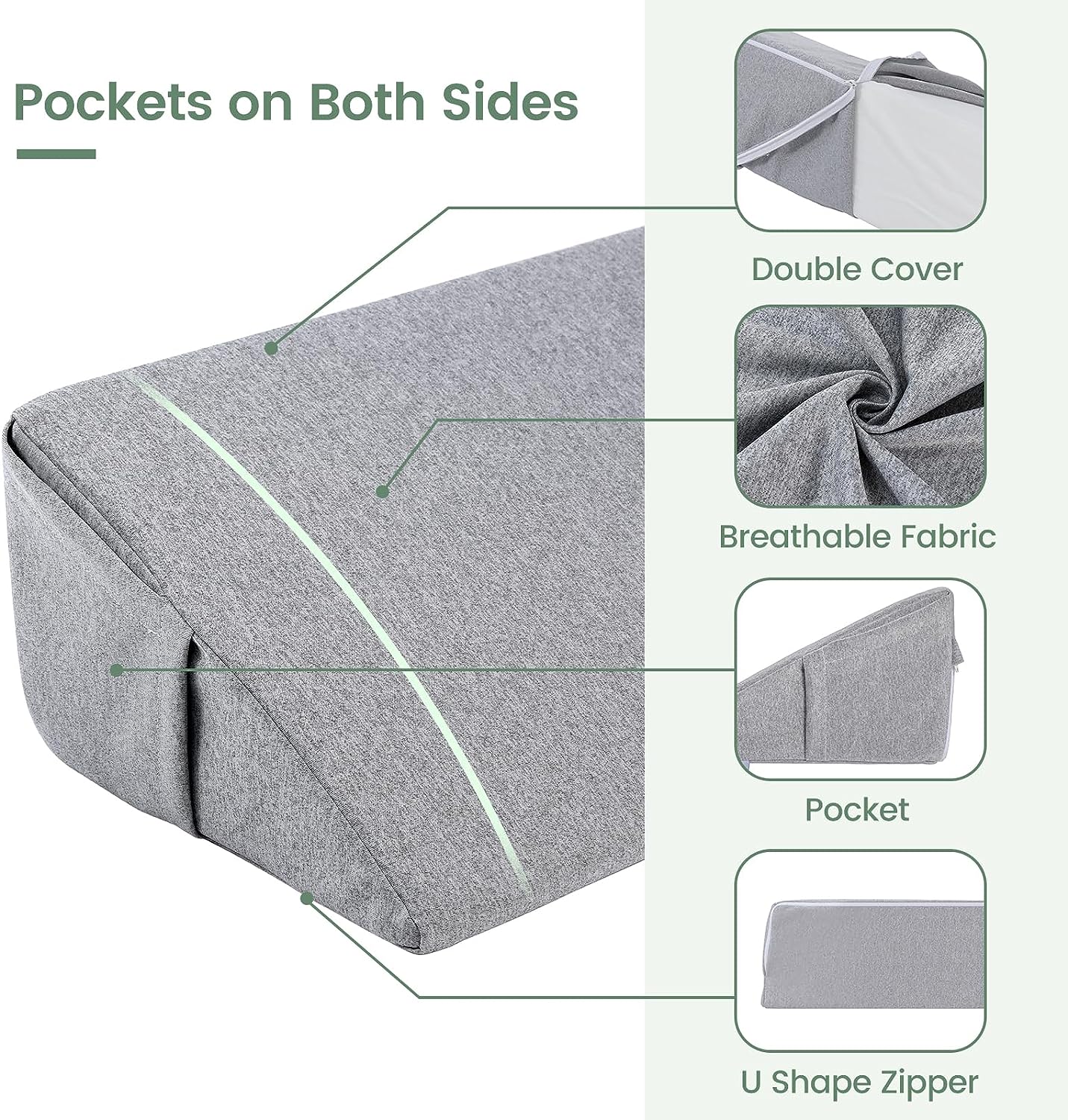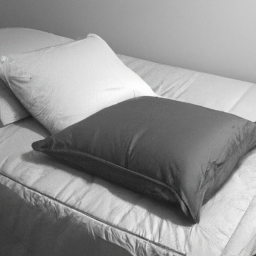Sleep apnea is a common sleep disorder affecting millions of people worldwide. It’s characterized by repetitive interruptions in breathing during sleep, which often results in poor sleep quality, daytime sleepiness, and various health complications. One effective way to manage sleep apnea is by using a bed wedge pillow. In this comprehensive article, we’ll explore how bed wedges for sleep apnea can help alleviate symptoms, discuss some popular options like Flexicomfort and Aeris, and provide a step-by-step guide on managing sleep apnea.
The Science Behind Bed Wedges for Sleep Apnea
Sleep apnea occurs when the muscles at the back of the throat relax, causing a temporary blockage of the airway. This leads to snoring and disrupted sleep. Bed wedges work by elevating the entire upper body part, ensuring that gravity helps keep the airway open. This reduces the chances of obstruction and helps to alleviate symptoms associated with sleep apnea, such as snoring and gasping for air.
How a Bed Wedge Can Improve Your Sleep
Let’s take John, for example. John had been suffering from sleep apnea for years, and his snoring and gasping for air were taking a toll on his quality of life. His doctor recommended trying a bed foam wedge pillow to get better sleep and help alleviate his symptoms. After just a few nights of using a bed foam wedge pillow, John noticed a significant improvement in his sleep quality. His snoring decreased, and he had better sleep and woke up feeling more refreshed.
Who Should Use a Wedge Pillow
Wedge pillows are not only beneficial for individuals with sleep apnea but also for a wide range of people seeking improved sleep quality and comfort. Those who suffer from acid reflux, gastroesophageal reflux disease (GERD), or heartburn can benefit from using a wedge pillow, as the elevation helps prevent stomach acid from flowing back into the esophagus. Similarly, people experiencing sinus congestion or allergies may find relief, as the elevated position aids in reducing nasal congestion and promoting better breathing. Pregnant women often find wedge pillows helpful in alleviating discomfort and providing additional support during sleep. Moreover, individuals dealing with back or neck pain can benefit from the extra support a wedge pillow offers, promoting proper spinal alignment and reducing pressure on the affected areas. Overall, a wedge pillow can be a valuable sleep accessory for a wide range of people seeking to enhance their sleep experience and alleviate various health-related concerns.
Choosing the Right Bed Wedge for Sleep Apnea
There are various bed wedges on the market, but two popular options worth considering are the Flexicomfort adjustable bed wedge pillow and the Aeris curved bed wedge pillow.
Flexicomfort Wedge Pillow
The Flexicomfort wedge pillow is designed to provide optimal support and comfort for individuals with sleep apnea. It’s made from high-quality memory foam that conforms to the shape of your body, providing a comfortable and supportive surface to sleep on. The pillow’s cover is removable and machine washable, ensuring a clean and hygienic sleep environment.
One unique feature of the Flexicomfort wedge pillow is its adjustable height. The wedge pillow comes with an additional memory foam pillow insert, allowing users to customize the angle of elevation to suit their specific needs. An adjustable wedge pillow typically has a foldable design or multiple components, allowing sleepers to stack parts of the wedge pillow for a higher or lower incline. This makes it ideal for individuals with varying degrees of sleep apnea severity.
What to Consider When Purchasing a Wedge Pillow
Wedge pillows have numerous advantages for sleeping and there are several key things that should be considered when buying wedge pillows for sleeping. This pillow is offered in a variety of sizes, shapes, and angles, each with specific requirements and desires. Understanding this information will help customers choose the wedge pillow for their needs based on their own needs. Customers must also be aware that bed-related retailers sometimes make misleading or exaggerated claims.
What to Consider When Purchasing a Wedge Pillow
Wedge pillows have numerous advantages for sleeping and there are several key things that should be considered when buying wedge pillows for sleeping. This pillow is offered in a variety of sizes, shapes, and angles, each with specific requirements and desires. Understanding this information will help customers choose the wedge pillow for their needs based on their own needs. Customers must also be aware that bed-related retailers sometimes make misleading or exaggerated claims.
Aeris Curved Wedge Pillow
The Aeris curved memory foam wedge pillow is another excellent option for sleeping individuals with sleep apnea. This pillow features a full memory foam wedge pillow with a unique curved design that follows the natural contour of the body, providing exceptional support to the head, neck, and shoulders while sleeping well. The high-density memory foam used in the Aeris pillow ensures that it maintains its shape and support over time.
The Aeris curved wedge pillow also comes with a washable, hypoallergenic bamboo cover that helps regulate temperature, keeping you cool and comfortable throughout a good night’s sleep.
A Step-by-Step Guide to Managing Sleep Apnea
Now that we’ve explored the benefits of bed wedges for sleep apnea, let’s discuss how to effectively manage sleep apnea with a step-by-step guide.
Step 1: Consult with a Medical Professional
If you suspect you have sleep apnea, it’s essential to consult with a healthcare professional for a proper diagnosis and treatment plan. They can determine the severity of your condition and recommend appropriate interventions, such as using a bed wedge pillow.
Step 2: Choose the Right Bed Wedge
Select a top memory foam bed wedge pillow that suits your specific needs and preferences. Consider factors like the angle of elevation, material, and design. As mentioned earlier, the Flexicomfort wedge pillow and the Aeris curved wedge pillow are both excellent choices for individuals with sleep apnea.
Step 3: Properly Position the Bed Wedge
Place the foam bed wedge down on your mattress, with the higher end towards the head of your bed. Ensure that it’s properly aligned with your upper body, allowing for optimal support and comfort. You may need to experiment with different positions to find what works best for you.
Step 4: Adjust Your Sleeping Position
Sleep on your back while using firm support from the bed wedge, as this position helps to relieve pressure and keep your airway open. If you’re used to sleeping on your side or stomach, it may take some time for your upper body to adjust to this new sleeping position.
Step 5: Incorporate Other Sleep Apnea Management Strategies
In addition to using a bed wedge, consider incorporating other strategies to manage your sleep apnea effectively. This may include losing weight if you’re overweight, avoiding alcohol and sedatives, practicing good sleep hygiene, and using a humidifier to maintain optimal humidity levels in your bedroom.
Step 6: Monitor Your Progress
Keep track of your sleep quality and any improvements in your sleep apnea symptoms. If you notice a significant improvement better quality sleep afterward, continue using the bed wedge and other management strategies. If your symptoms persist or worsen, consult with your healthcare professional to discuss alternative treatments, such as continuous positive airway pressure (CPAP) therapy.
Step 7: Maintain Your Bed Wedge
To ensure the longevity of the memory foam pillow used inside your bed wedge, regularly clean the cover and follow the manufacturer’s care instructions. This will help maintain a hygienic sleep environment and preserve the quality of the foam inside your sleeping wedge pillow.
Step 8: Experiment with Additional Sleep Accessories
To further enhance your sleep experience and address sleep apnea symptoms, consider incorporating additional sleep accessories. For example, an anti-snore pillow designed to support the neck and maintain proper spinal alignment can be used in conjunction with a foam bed wedge pillow. Additionally, a body pillow may help side sleepers maintain a comfortable and stable position, further reducing the risk of airway obstruction.
Step 9: Reevaluate Your Sleep Apnea Management Plan Periodically
As your needs and circumstances change over time, it’s essential to reevaluate your sleep apnea management plan periodically. If you’ve experienced significant weight loss or gain, for instance, the severity of your sleep apnea may change, and your bed wedge and other management strategies may need adjustments. Schedule regular follow-ups with your healthcare professional to discuss your progress and make any necessary modifications to your sleep apnea treatment plan.
Q: How do I know if I have sleep apnea?
A: Common symptoms of sleep apnea include loud snoring, gasping or choking during sleep, restless tossing and turning, frequent nighttime awakenings, excessive daytime sleepiness, difficulty concentrating, and morning headaches. If you suspect you have sleep apnea, consult with a healthcare professional for proper diagnosis and treatment.
Q: Can I use a bed wedge for other health conditions besides sleep apnea?
A: Yes, bed wedges can also help to relieve pressure and alleviate symptoms of chronic pain associated with other health conditions, such as acid reflux, gastroesophageal reflux disease (GERD), sinus congestion, chronic pain, and back or neck pain. Always consult with a healthcare professional before using a bed wedge for pain relief for any medical condition.
Q: Can I use a bed wedge in conjunction with a CPAP machine?
A: Yes, many individuals with sleep apnea find using a bedside wedge pillow in combination with their CPAP machine provides additional pain relief and comfort. However, it’s essential to consult with your healthcare professional to determine the best treatment plan for your specific needs.
Q: How long will it take to adjust to sleeping with a bed wedge?
A: The adjustment period to sleeping with a supportive wedge pillow also varies from person to person. Some individuals may adapt quickly to sleeping with a bed the wedge pillow helps them, while others may take several nights or even weeks to get used to the new sleeping position. Be patient and give yourself time to adjust.
Q: Can I use a regular pillow instead of a bed wedge for sleep apnea?
A: While using multiple pillows to elevate the sleep position of your head may provide some relief from a sleep apnea pillow, it’s not as effective as using regular pillows or a bed wedge specifically designed for sleep apnea. Bed wedges provide consistent support and elevation, which is crucial for maintaining an open airway and reducing sleep apnea symptoms.
Q: Can I use a bed wedge if I’m a side or stomach sleeper?
A: While back sleeping is the sleep position generally recommended for individuals with sleep apnea, you can still use a bed with wedge pillows if you prefer to sleep on your side or stomach. However, it’s essential to ensure that the wedge pillow provides adequate support and maintains an open airway in these positions. You may need to experiment with different side wedge pillows and pillow designs to find the best fit for your preferred sleeping position.
Q: Are there any potential drawbacks or side effects of using a bed wedge for sleep apnea?
A: Although using a bed wedge can significantly improve sleep apnea symptoms for many individuals, there are a few potential drawbacks or side effects to consider:
- Adjustment period: As mentioned earlier, it may take some time to get used to sleeping with a bed wedge, particularly if you’re accustomed to sleeping on your side or stomach. Be patient during this adjustment period.
- Discomfort: Some individuals may initially experience discomfort or stiffness when using a bed wedge, particularly in the neck, shoulders, or lower back. Choosing a bed wedge with the appropriate elevation and support for your body can help minimize this discomfort.
- Sliding or shifting: If the bed wedge isn’t properly secured or positioned, it may slide or shift during the night, which could affect its effectiveness in keeping your airway open. Make sure to place the wedge securely on your mattress and align it with your body for optimal support.
Despite these potential drawbacks, many individuals with sleep apnea find that using a bed high-quality wedge pillow significantly reduces pressure and improves their sleep quality and overall well-being. As always, consult with a healthcare professional to determine if a bed that uses a foam wedge pillow is the right solution for your specific needs.
In Conclusion 💭
Bed wedges for sleep apnea, such as the Flexicomfort wedge pillow and the Aeris curved wedge pillow, can provide significant relief for individuals suffering from this sleep disorder. By following our comprehensive step-by-step guide to managing sleep apnea, which includes consulting with a medical professional, choosing the right bed wedge, properly positioning the foam bed wedge, adjusting your sleeping position, incorporating other sleep apnea management strategies, monitoring your progress, maintaining your bed wedge, experimenting with additional sleep apnea pillow and accessories, and periodically reevaluating your sleep apnea management plan, you can improve your sleep quality and overall well-being.
Remember to consult with a healthcare professional for a proper diagnosis and treatment plan, and always listen to your body when making adjustments to your sleep environment. Additionally, don’t be afraid to experiment with other sleep accessories or make changes to your sleep apnea management plan as your needs evolve. With patience, persistence, and the right tools, you can effectively manage sleep apnea, improve sleep quality, and enjoy a more restful night’s sleep.



